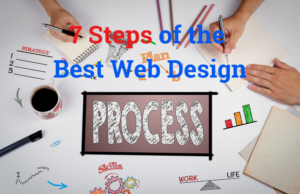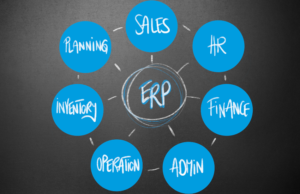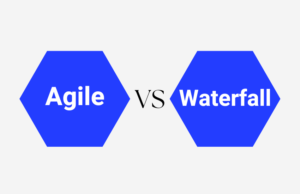Are you looking to create a stunning website but don’t know where to start?
Maybe you think that a good website is just about designing UI, UX, content, and elements.
But it is not just about designing an eye-catchy website.
Website development is a complete strategic process that results in a website that really converts and attracts users to spend time and take action on your words.
In this definitive guide, I am going to explore the 7 steps of the web design process when it comes to creating the perfect website from start to finish. So, no matter your level of experience, you’ll be able to create a fantastic website that perfectly meets your needs.
Let’s start the journey!
Here Are the 7 Steps of Best Web Design Process
- Goal Identification
- Scope of your website
- Sitemap and Wireframing
- Content for Website
- Visual Content
- Development and Testing
- Launch your project
Goal Identification
Goal identification is the key part of every planning; how can you avoid this while making your website the virtual office of your business in the digital world?
Accurately defining your goals helps you to create a plan that works towards meeting those objectives while also allowing you to track success and measure return on investment.
The goal identification process starts with analyzing your current situation, what is working well and what needs improvement.
You Need to Identify the Purpose behind the Website
What do you want it to achieve?
Is it meant for customer sales, education, or business branding?
Thinking about Who Is Going to Use It Can Help Focus Your Planning
Is it designed for a consumer audience or for business users?
Knowing this will provide insight into how best the website can be designed and presented.
For larger projects, it’s helpful to consult stakeholders – people inside or outside of the organization with an interest in web design outcomes – as they may have valuable insights into user requirements.
You should also seek out experts in fields such as SEO who can offer support throughout the project.
By focusing on measurable goals before beginning web design, organizations better position themselves for success. Identifying these objectives up front avoids costly delays and issues by ensuring all team members are aware not just of “what” needs to be created but “why” it must meet specific criteria and “how” this can be done effectively.
Scope of Your Website
The second most important part of the web design process is defining your website’s scope. Definitely, it’s not an easy part to do because the project scope may change over time due to changes during the process.
Starting a web design project without defining any scope is like creating an unrealistic thing.
Having an idea of how much time and budget can be allocated to the project is important for setting realistic expectations before commencing any work.
Scope of the website development should include how much time is required to complete, how many pages the website should have, what features should have in the website, and what functions should have in the website.
Furthermore, you should consider whether you are planning regular maintenance updates or only one big launch and then no further changes. Also, consider whether official company branding or specific layouts already exist that must be maintained going forward into any redesigns/updates/iterations, etc.
Taking into account requirements from stakeholders at an early stage helps keep any additional requests or ‘scope creep’ from sabotaging developments downstream, which could easily cause deadlines to slip further back than anticipated & force costs up accordingly.
By defining the scope of web design, it will be easy for you to achieve the expected results in a better way.
Sitemap and Wireframing
Sitemap and wireframing come third in the web design process. A sitemap is a document that lists all of the pages on your website. A wireframe is a simplified website version that is used to create a realistic and functional design.
Wireframing is the process of creating a blueprint for your website that deals with layout, functionality, navigation, and aesthetics. The point is to identify what goes on each page and get an overall idea of how it will fit together.
A sitemap is the website’s structure of all URLs or pages which defines the relationship between different pages means navigation structure. A sitemap helps developers understand the better structure of the website pages, like how the pages will work together.
Before going to the wireframing step it’s important to start by creating a well-structured sitemap so you can easily figure out the locations for different types of content.
Once you have created a sitemap, you can start to create a wireframe. Wireframing allows you to plan how the different elements will be organized on each page before beginning the coding process, which tends to save time further down the road in case you need to make changes or reorganize elements on your site. Also, wireframing helps convey initial ideas from stakeholders as well as client review.
Together they help ensure a smooth development process while factoring usability into account at later stages like once feedback comes in or during development times when various assets are added into consideration.
Content for Website
After completing the above steps, now come to the most important part of any website, which is content. Yes, content is the King of the web and will always be.
You’ll need to determine what content should be included, how it will be structured, and how the information will be organized. Creating content first allows you to decide how best to visually represent the information aesthetically.
Each website should have an overall goal or purpose that drives your content. It’s important to note that your goal can change over time; understanding how your visitor’s goals and interests evolve as they use your site is key to successful web development.
Establishing what your website is about and ensuring its relevancy also helps increase visibility in search engine rankings.
Consider designing a site map before writing actual text so you can visualize the flow of information through the pages of the website. This practice will help inform where certain links go and provide structure for developing content topics and visual ideas.
Additionally, narrative writing should take place after designing wireframes and clearly understanding the layout so that words are not cramped or stripped off due to lack of space or sections being removed during design iterations.
Before publishing, ensure all finalized content is proofread properly through basic grammar checkers like Grammarly (or manually checking) for spelling/grammar mistakes. These small issues can majorly impact visitor’s impressions of the website’s overall quality.
Purpose of the Content
Having content on your website is essential to succeed. Not only should the content be engaging, but it should also be search engine optimized (SEO). The right type of content can help you generate more interest and visitors.
Content should provide the information your visitors are looking for, such as product information, company background, product reviews, and more. Your content aims to provide readers with a good experience by being informative and engaging.
In addition, content allows you to share your brand’s story with potential customers as well as allow them to learn more about what you offer and how it can benefit them.
Good website content improves the ranking of your website on search engines like google or bing making your website more visible to search engines and helping it to rank higher in search engine results pages.
Visual Content
A picture speaks a thousand words, you may hear about this, and this is 100% right. According to the research, more than 90% of people prefer visualized content over long-form written content.
Visual content and written content combination of both gives a great impact on your website. People do not only read the text but also see pictures. They explain better than text alone, which is why visual content gives better results.
Visual content includes images, videos, and animations.
Images: Images are one of the most effective ways of getting your website noticed. Images explain better than text and catch the eye of the user. They can also be used to catch the attention of the user, and this can turn him into a potential customer.
Video: Videos are great ways of advertising through your website. You can use video to show your website’s products, websites, or services or to tell people about your company.
Animation: Animation is considered to be the King of visual content. People are attracted to animation, and they like to watch animated things. Animation attracts customers by making them click on your site.
Strong imagery and videos can make all the difference in grabbing a user’s attention and engendering trust as they view your offerings.
Choosing visually interesting backgrounds, along with appropriate text elements and headings, will help portray professionalism and create an inviting environment for visitors of all levels of experience across many devices.
When using visuals, it is important to remain consistent; if there are too many unrelated images or if they do not agree with one another, it creates confusion and makes navigation difficult, leading visitors away from your page instead of further into it.
Development and Testing
Your design thinking and content creation have been completed. Now go for the technical part of website development.
Your website must be perfect according to technical aspects as there are millions of website on google competing for their ranking on the first pages of google, Google algorithm don’t decide the rankings of the website just based on content. The technical side is the most critical side which impacts your website’s ranking. Which includes;
Website speed should be very good, which is less than 3 seconds; the website should be responsive and optimized for Mobile & Tablets.
If you are not technical enough, don’t put your whole web design process in a compromising situation; you should hire some professionals who can do it for you, from web development to content creation and SEO.
Once the development is complete, testing the site on multiple devices and operating systems is important. Check both desktop computers, smartphones, and tablets. Always test using different browsers like Google Chrome, Safari, Internet Explorer, and Firefox since each evaluates codes differently, leading to different presentation results across systems.
Test every page within your website for responsiveness on various screen sizes by opening them up in different browsers during the development phase so any problems can be quickly dealt with before launch day arrives.
Don’t forget to take feedback from your stakeholder after completing the website development process.
Launch Your Project
Launching your project is the last but most important step in the web design process. Now that you’ve planned and developed your dream website, it’s time to make it available for your users. The goal is to ensure the visitors are delighted when experiencing all your website offers!
Once you’re ready to put your site live, there are a few things you should consider.
First, you should register a domain name. This will be the address people type in to access your websites, such as mydreamsite.com or mybusinesssite.com.
Make sure you check out any restrictions your web hosting provider may have regarding top-level domains since some countries have their domain extensions like .UK or .IN, which can have different requirements than others.
Second, you need a secure web hosting service so that online visitors know their data and personal information is secure while engaging with or transacting on your website (such as when making a purchase). The hosting provider will also support making sure it runs smoothly, keeping the site up-to-date with bug patches and security updates as needed.
Once all of this is set up and ready to go, it’s time for launch day! Be prepared for glitches by running all of these processes before launch: complete testing of all website functions; running compatibility checks across mobile devices/tablets/desktops; conducting SEO analysis; verifying analytics codes; creating a post-launch feedback process; ensuring privacy policy compliance; and more!
Finally, be sure to remain accessible after launch — this means regularly monitoring progress from page load times to any customer inquiries! With these steps in place, you can feel confident knowing that everything has been done before your project is implemented!
Wrapping Up
Creating a successful website requires more than just great design. It requires an in-depth strategic process that combines research, planning, development, testing, and ongoing optimization to ensure the best user experience.
By following the above 7 steps for creating successful web design projects, you can create powerful digital solutions that stand out in the market.
If you feel the above process is difficult, you can take professional web design and development services from Codecentro. We are always available at your service.
I hope you enjoy the article and understand the web design process.






